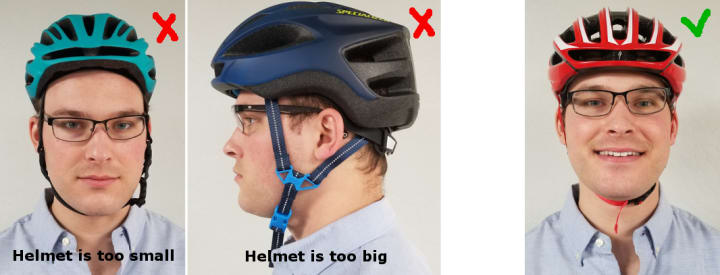How to Find the Right Bicycle Helmet Size
Use our comprehensive size chart to find the perfect fit for your new bicycle helmet.

If you enjoy cycling, one of the most important things you can do to ensure your safety is to wear a properly fitting helmet. In this article, we will discuss the steps you should take to find the right bicycle helmet size.
Why is finding the right helmet size important?
Before we dive into the steps, it's important to understand why finding the right helmet size is so crucial. If your helmet is too loose, it won't provide adequate protection in the event of an accident. Conversely, if your helmet is too tight, it can cause discomfort and even headaches during long rides.
Step 1: Measure your head
The first step in finding the right bicycle helmet size is to measure your head. To do this, wrap a tape measure around the widest part of your head, which is typically just above your eyebrows. Make sure the tape measure is level and snug, but not too tight. Take note of the measurement in centimeters or inches.



Step 2: Check the helmet size chart
Once you have your head measurement, it's time to check the helmet size chart. Most helmet manufacturers provide a size chart that correlates head circumference with helmet size. Find the size chart for the helmet you are interested in and locate the size that corresponds with your head measurement.
Step 3: Try on the helmet
Now that you have identified the appropriate helmet size, it's time to try it on. Put the helmet on your head and adjust the chinstrap so that it is snug but not too tight. The helmet should sit level on your head and cover your forehead without obstructing your vision.
Step 4: Check the fit
After you have adjusted the chinstrap, it's important to check the fit. First, check the position of the helmet. It should sit level on your head and not tilt forward or backward. Next, check the fit around the forehead. There should be no more than one finger's width of space between your forehead and the helmet. Finally, check the fit around the temples and the back of the head. The helmet should fit snugly without being too tight.
Step 5: Take a test ride
Before you make your final decision, it's important to take a test ride with the helmet on. This will allow you to ensure that the helmet doesn't move around or shift during a ride. It's also a good opportunity to ensure that the helmet is comfortable and doesn't cause any discomfort or pressure points.
Step 6: Check for certification
Finally, before you make a purchase, it's important to check for certification. Look for a sticker or label inside the helmet that indicates that it meets the safety standards set by organizations such as the Consumer Product Safety Commission (CPSC) or Snell Memorial Foundation.
Conclusion
Finding the right bicycle helmet size is crucial to ensuring your safety while cycling. By measuring your head, checking the helmet size chart, trying on the helmet, checking the fit, taking a test ride, and checking for certification, you can be confident that you have found a helmet that provides the necessary protection and comfort for your cycling needs.
FAQs
What if my head measurement falls between two sizes on the helmet size chart?
If your head measurement falls between two sizes on the helmet size chart, it's generally best to go with the larger size. You can always adjust the fit with the chinstrap and padding.
Can I wear a helmet that is too big or too small?
No, it's important to wear a helmet that fits properly to ensure adequate protection and comfort.
Should I buy a helmet online or in-store?
While it's possible to buy a helmet online, it's generally recommended to try on the helmet in-store to ensure the best fit. If you do decide to buy online, make sure to check the seller's return policy in case the helmet doesn't fit properly.
Can I use a helmet that has been involved in a previous accident?
No, if a helmet has been involved in an accident, it should be replaced immediately, even if there is no visible damage. The impact can compromise the helmet's ability to protect your head in the future.
How often should I replace my helmet?
It's generally recommended to replace your helmet every 3-5 years, even if it hasn't been involved in an accident. Over time, the materials can degrade and the effectiveness of the helmet can be reduced. Additionally, if you have been in an accident, the helmet should be replaced immediately.
About the Creator
Hopika Inc
Our sophisticated collection of women's clothing delivers an uncompromising blend of fashion, comfort and functionality. Look stylish wherever the day takes you from a casual outing at the cafe to a night out with friends or shopping spree!






Comments
There are no comments for this story
Be the first to respond and start the conversation.